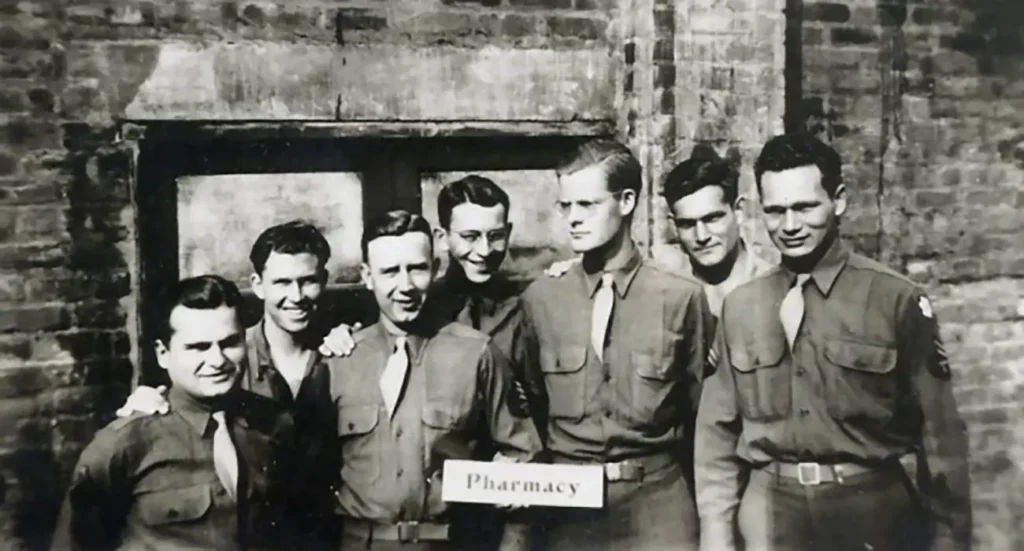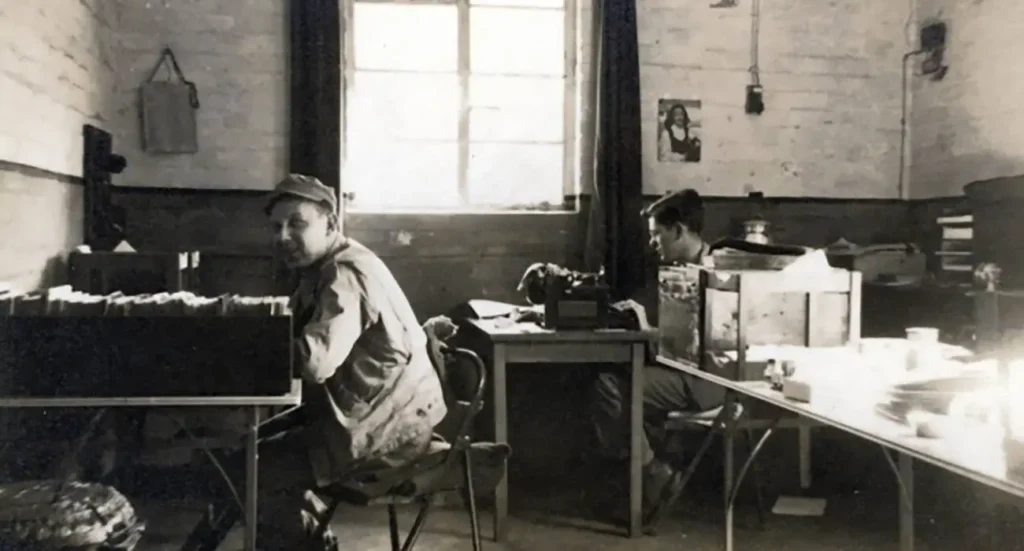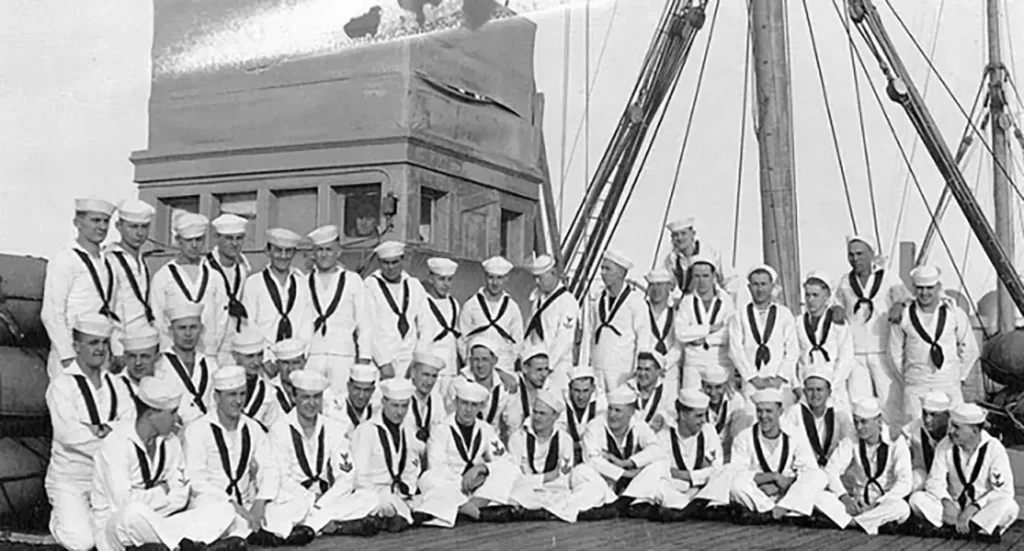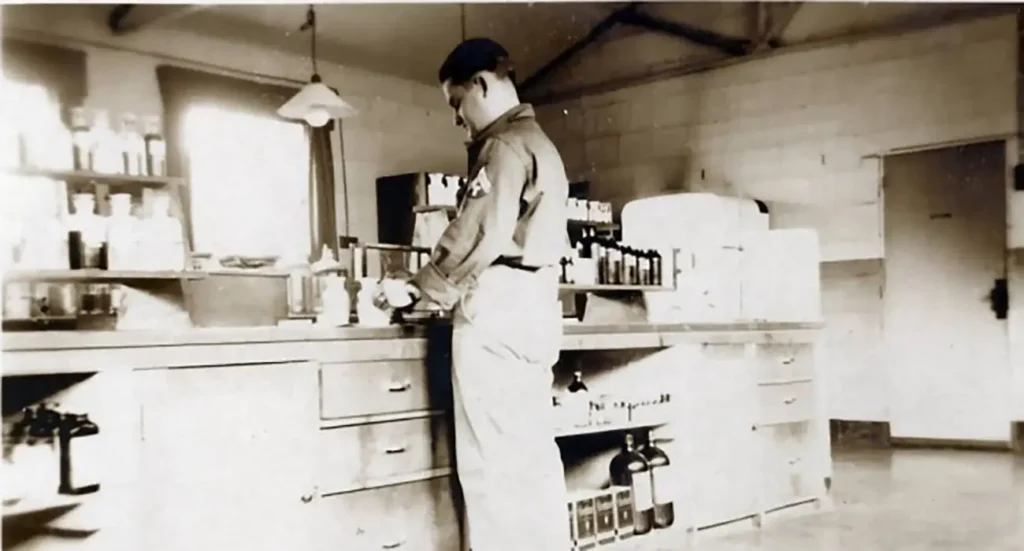World War II Records: Stateside






Wilbur S. Anderson (Army, Manhattan Project) Video | Transcript 1 | Transcript 2 | Documents
Wilbur Stocker Anderson was born on 15 May 1915 in Illinois. Anderson attended Purdue University and graduated with a degree in Civil Engineering. He worked as a fire suppression engineer and fire safety inspector until 1943, when he was drafted. Anderson’s supervisor wrote the draft board requesting that he be excused due to the necessity of his job. They refused, and on September 11, 1943, Wilbur Anderson entered the Army as a military police officer. A year into his enlistment, the Army sent Anderson to Officer Candidate School (OCS), where he trained to become an officer in the Corps of Engineers. On 27 December 1944, Wilbur graduated from OCS and was stationed at Oak Ridge. As a part of his duties at Oak Ridge, he transferred uranium to Chicago, where he passed the cargo to another courier who would take the uranium to Lamy, New Mexico, to be used on the bomb. On 31 July 1946, Wilbur Anderson left the military. Wilbur died in early 2004, keeping his role in the development of the bomb a secret even to his family.
**Please note: Due to a large file size, a download is required to view Wilbur S. Anderson’s documents.
Robert W. Barbee (Army)
Robert W. Barbee graduated from the University of Tennessee in 1936 and was commissioned as a 2nd lieutenant in the Army Reserves as part of The Corps of Engineers. He was ordered to active duty on July 15, 1941. From December 7, 1942 until January 27, 1945, Barbee was stationed in Memphis in the Corps of Engineers Construction Program where he was in charge of construction at 22 military facilities in West Tennessee and North Mississippi, and one base in Arkansas. From March 15, 1945 to November 24, 1945, Barbee was stationed in The Philippines. Barbee underwent five cancer operations from 1980 to 1986 and eventually became cancer free and was feeling well enough to “complete some unfinished business.”
Joe Billig (Army) Audio | Transcript
Joe Billig moved to Knoxville in February 1931 when he was 12 years old. His family owned a jewelry store in Knoxville called Max Friedman Jewelers. Later, he joined the infantry a year after Pearl Harbor. Due to some issues with his feet, Billig’s company was sent overseas without him, and Billig was later told that 90% of that company was lost on D-Day. The rest of the account is Billig’s experiences in the Army.
Erlene Aytes (Army) Audio | Transcript
Erlene Aytes served as a secretary for the three commanding officers at the Crossville Internment Camp located in Cumberland County, Tennessee. She applied for a job at the camp several months after it had opened in November of 1942. There she would encounter fights among Italian and German prisoners, unruly camp commanders, and even escaped prisoners. Ms. Aytes would spend the entire war working skillfully for the organization and care of all the enlisted men and prisoners within the camp. She insisted on being the last one to leave when it closed doors in 1945, to make sure everyone had been taken care of and returned home. Her sense of duty in such a difficult environment is a testament to the courageous women who served at home during the war.
Richard Lowell Blanchard (WNOX Radio Station) Documents
From Palmer, Illinois, Blanchard moved to Knoxville, Tennessee in 1936 after attending the University of Illinois. He worked as an emcee for WNOX for two decades and throughout World War. Blanchard was never drafted, but served in local politics during the war while also continuing wartime broadcasts through the radio station. He also worked as a broadcaster for the UT Volunteer sports teams, the Knoxville Bears and Smokies baseball teams.
William F. Bowman (Marines) Audio | Transcript
William F. Bowman joined the Marines in 1943 and later became an aviation instructor. Bowman’s account details his training, his travels, and aviation production in the 1940s. William F. Bowman joined the Marines in 1943 and later became an aviation instructor. Bowman’s account details his training, his travels, and aviation production in the 1940s.
W. A. Carter (Army) Transcript
W. A. Carter was part of the North Carolina National Guard and was eventually sent to Fort Benning, Georgia, for the Army Specialized Training Program. Soon, he was transferred to the Army Transportation Corps in New York City, where he worked with V-Mail. He eventually served a brief stint in the Pacific near the end of the war.
Harold Diftler (Navy) Audio | Transcript
Born December 14, 1927 in Knoxville, TN at Fort Sanders Hospital; father immigrated to U.S. from Austria; uncle a World War I veteran for the Central Powers Jewish family; Jewish community in Knoxville; Participated in ROTC at Knoxville High School; graduated high school in 1945; drafted into U.S. Navy; trained at Fort Oglethorpe, GA and in California in 1946; active in navy March-June 1946; guard duty in the navy; attended dental school in 1954; established a dental practice.
Stanley Duhan (I) (Navy) Audio | Transcript
Born March 12, 1926 in New Rochelle, NY; mother from Philadelphia; father from Latvia; Jewish family; early life in urban New York; studied mechanical engineering at Virginia Tech; drafted into U.S. Navy; trained at the Finger Lakes Region, MI in 1944; trained in Chicago and Gulf Port, MS in April, 1945; attended radio school at the naval station in Millington, TN; discharged 1946; G.I. Bill to finish school at Virginia Tech; became engineer in Seymour, CT; remained in reserves with Floyd Bennett Field on Long Island, NY; Industrial Engineer; trained as a reservist during Korean War; Installation Squad; Worked on the Titan and Atlas Projects in 1960s; worked for TVA.
Stanley Duhan (II) (Navy) Audio | Transcript
Postwar engineering school at Virginia Tech; commissioned as a reserve Airforce officer during the Korean War; training at Floyd Bennett Field, NY; composition of reserve unit; differences between Navy and Airforce; enlistment in Air Guard after Korean War; engineering work in military related industries; work designing componets for ICBMs and CH-47 helicopter; work with the Department of Energy and Tennessee Valley Authority; impressions of reports from Vietnam regarding equipment; design of missle silos; activities with veterans’ organziations.
Lionel Greer (Army) Audio | Transcript
Born in 1923 in the Bronx; Hungarian heritage; parents immigrated through Ellis Island; childhood in the Bronx; studied French and German in high school; ROTC; worked as an accountant; served in U.S. Air Force; trained at Fort Dix; stationed in Atlantic City; AGCT Degree in June 1942; studied at City College School of Business (Baruch College); navigator; second lieutenant; radar school in Victorville, CA.
Claude Hobler (Army) Audio 1 | Audio 2 | Transcripts
Claude Hobler joined the Army on November 14, 1940, and fought in World War II and the Korean War. Hobler was assigned to the chemical corps and was part of a mortar battalion, only to be transferred to help the Army Air Corps by teaching young cadets about chemical warfare. By the war’s end, Hobler was shipped to Japan to aid in the occupation force there.
Aston Kennedy (Local Historian) Audio | Transcript
Aston Kennedy’s recording provides the listener with some history of the Tennessee State Guard. Kennedy discusses certain figures and events about this Guard’s history.
Jim Lovett (Army, Calvary) Audio | Transcript 1 | Transcript 2
Jim Lovett enlisted in the army in the Summer of 1940. Lovett was sent to the 3rd Cavalry and trained at Fort Myer, Virginia. Lovett’s account traces his trainings with horses, his training of other recruits, and his short time in the Philippines.
W. Ralph Lufkin (Army) Audio 1 | Audio 2 | Transcript 1 | Transcript 2
W. Ralph Lufkin enlisted in the Army in 1941 and during basic training decided to specialize in the ministry, eventually being assigned as a Chaplain’s Assistant at Camp Tyson, Tennessee. Eventually, Lufkin would be assigned to an engineer combat group. Lufkin’s account details his experiences as a military chaplain alongside his time stateside as his unit was never officially moved out to the European or Pacific theaters of war.
Charles Manning (Army) Audio 1 | Audio 2-3 | Transcript 1 | Transcript 2 | Transcript 3
Charles Manning was part of the First Battalion of the 157th Field Artillery in the State of Colorado National Guard. This recording is a sermon he gave indicating that God chose the United States to stop World War II. The recording is full of religious fervor.
Lindsey Nelson (Talk) Video | Transcript
The following is a talk given by Lindsey Nelson to the East Tennessee Historical Society on February 4, 1986, as recorded by Charles Johnson of the Department of History, University of Tennessee. The talk details local Tennessee history with the war, including that of Robert Reese Neyland, who was an American football player, coach, and officer in the United States Army, reaching the rank of brigadier general.
Charles Dalph Ottinger (Army Air) Documents
Charles Dalph Ottinger born on February 27th of 1923 to Milburn Estel Ottinger and Bonnie Mazuri Wills in Knoxville, Tennessee. At the age of just 19 years old, Ottinger enlisted in the United States Army where he would serve as a flight engineer on B-17 fortress bombers. During his time in the Army, Ottinger earned the rank of Sergeant. On the night of August 28th or 1943, Ottinger tragically lost his life during a routine training flight in which three planes collided in the air killing 14 men in total. Ottinger was laid to rest at the Oak Grove Cemetery in Greenville, Tennessee and at the time was survived by his mother, father, and sister.
Rocky J. Petrella (Military Police) Audio | Transcript
Rocky J. Petrella worked as a welder in Niles, Ohio, building 40-millimeter anti-aircraft guns in 1939. Petrella was inducted into the Army Air Force in June 1942. He was assigned to the military police at Mitchell Field Air Force Base in New York. He describes his experiences and an interesting anecdote of the FBI looking for AWOL soldiers in New York City.
Ellen Cleminshaw Weaver (Manhattan Project, Civilian Chemist) Documents
Ellen Weaver was a female chemist from Oberlin, Ohio who worked in Oak Ridge, Tennessee on the Manhattan Project. Weaver went on to earn a PhD at California State and worked as faculty at San Jose State University. She also served as president of the Association of Women in Science.
Ed Westcott (Manhattan Project, Army Corps of Engineers, Photographer) Documents
Ed Westcott was from Chattanooga, Tennessee. He worked as a photographer for the Army Corps of Engineers on New Deal projects like the WPA before the war. He was posted as the only photographer given full access to document the Manhattan Project in Oak Ridge, Tennessee during World War II. He continued to work for the Atomic Energy Commission after the war.
